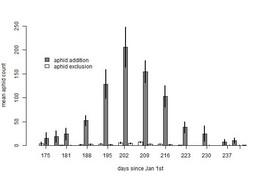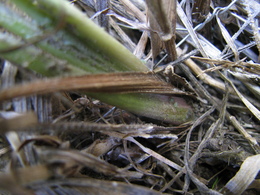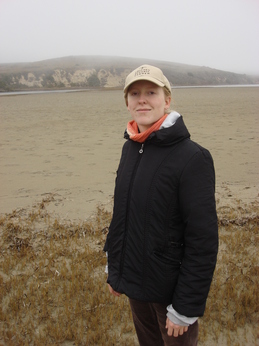|
|
During the summers of 2011 and 2012, I conducted a survey of aphid infestation in a section of the main experimental plot to track, among other things, seasonal changes in the distribution and abundance of Aphis echinaceae on Echinacea. With help from members of team Echinacea, I conducted 6 bi-weekly surveys in 2011 and 3 monthly surveys in 2012. In both years there was a sharp rise and fall in the frequency of aphid infestation. The plot below shows the percentage of plants in the survey area observed to have 1 or more aphids on each dates. In 2011, the peak of aphid infestation (i.e. when the highest percentage of plants hosted aphids) was around August 12th. In 2012, the peak date of aphid infestation occurred some time between July 13th and August 9th. I was not able to observe the peak directly due to a sudden die-off of aphids before my third survey. I estimated the peak frequency of aphids as the percentage of plants with live or dead aphids on August 10th (indicated by the asterix and x-error bar).

I was also able to get a sense of aphid phenology from my aphid addition/exclusion experiment. In 2011 and 2012, I added or excluded aphids from 100 plants that were not flowering in 2011. The graph below shows the mean abundance of aphids in each experimental group over the summer of 2012:

Based on this graph, I estimate that the peak of aphid infestation for 2012 occurred around July 22nd (202 days after January 1st), about two weeks before last year’s peak.
Like their hosts, Echinacea aphids exhibit a strong seasonality. There’s a sharp rise in the frequency and abundance of aphid infestation followed by a rapid decline in early fall. That decline has occurred much earlier this year than last year. Fortunately, that has given me a chance to make some observations about what happens to aphids at the end of the summer. Here are a few things I’ve noticed:
1. Throughout my surveys in CG1 and several prairie remnants, I’ve noticed that the frequency of winged morphs has declined since July. Last week, I did not see any winged aphids, with the exception of a couple at East Elk Lake Road. This implies that dispersal declines as aphid numbers drop.
2. I and several others have noticed that aphids are starting to congregate at the base of the plant both at the petioles and at the base of the stem. I’ve also seen aphids crawling down beneath the soil surface and a few latched onto the tops of roots. One possibility is that as plants withdraw resources from their leaves, aphids move down the plant to follow their food source. I’ve also seen ants moving aphids at the base of the plant and placing them in dirt structures. These observations support the notion that aphids overwinter on Echinacea roots.
Many aphid species in temperate regions spend the winter and summer on different plants. Their winter host is where they lay eggs and their summer host is where they feed and reproduce asexually. My guess is that Aphis echinaceae does not have a separate winter host.
This plant at Nessman’s had a bunch of aphids congregated at the base. Notice the little green guys on the stem:

This is one of the plants from my aphid addition/exclusion experiment in CG1. There are still aphids on the leaves, but most of them have moved to the petioles:

I don’t know if I’ve properly introduced myself on here.
My name is Katherine Muller and I’m a second year Master’s student at Northwestern. I hail from the lovely, temperate San Francisco Bay Area. I’m not sure whether it was my thirst for adventure or my contrarian nature that led me to the Midwest–first to Oberlin College in Ohio, then to Northwestern and Minnesota. In any case, I now have the privilege of complaining about the weather.
This is my second year with the Echinacea Project. Last year I began research on aphids and ants in Echinacea angustifolia. I have two projects that I plan to continue this summer:
My first project is an experiment examining the effects of aphid infestation on Echinacea. Last year, I selected 100 non-flowering Echinacea, excluded aphids from 50 plants and added aphids to the other 50. I am repeating the experiment on the same plants. I performed my first experimental treatments on Saturday and Sunday and should soon be able to analyze my results from last year.
The other project I plan to continue this year is a survey of aphids and ants in a large experimental common garden. Last year I selected a 20x20m section of the experimental plot and led a biweekly of ants and aphids. I started this because I was interested in seeing how aphids spread over space and time. This year I will examine the same area to see how aphid infestation changes from year to year. Thanks to everyone’s help, I collected my first dataset on June 15th. Considering the unusually warm winter, there should be some interesting developments this year.
My third project is to assess aphid and ant abundance among several Echinacea populations. My original plan was to survey aphids and ants on a representative sample of the entire population, including juvenile and non-flowering plants. As it so happens, Amy Dykstra and Daniel Rath conducted a similar survey in 2009 (you can read about it in the archives). For all their hard work, they found very few plants with aphids. Of the plants they surveyed–flowering plants had a much higher rate of aphid infestation than non-flowering plants–32% for flowering versus 5% for non-flowering plants. I decided to take a different approach and focus my sampling effort on flowering plants. Specifically, I will survey aphid and ant abundance on plants that flowered this year and last year. This will allow me to assess whether flowering in one year influences the likelihood of aphid infestation the following year.
That’s about it for now. I’ll be posting my progress on here as it happens. This summer I have the privilege of collaborating with Jill Gall, an REU student from College of the Atlantic. She’s been hard at work preparing her project assessing ant diversity in prairie remnants, which I’ll let her tell you about.
And because everyone else is doing it, here’s a picture:

Last summer I conducted a biweekly survey of aphids and ants in the common garden, an experimental prairie restoration containing Echinacea from various remnant populations. I was interested in the spatial distribution of aphids and ants within and across years. This year I plan to scale down my survey to once a month, beginning next Friday. Here’s a detailed protocol:
Common Garden Aphid Survey Protocol 2012.doc
I couldn’t make the Midwest Ecology and Evolution Conference, but I made a poster. It describes preliminary results from an aphid addition/exclusion experiment I conducted in the summer of 2011. Specifically, it examines the question of whether aphid infestation influences the presence of leaf damage by other herbivores.
MEECPosterKMullerFinal.pdf
It’s been a busy week for everybody. Plants are blooming, pollen is shedding, and everyone is dashing about madly to catch the field season before it passes us by. I have been running around like a chicken with its head cut off trying to get ready for my aphid addition/exclusion experiment. Everyone has been a wonderful help setting up cages in this sweltering heat. My goal for this week is to finish my first round of experimental treatments: exclusion on Thursday and addition on Friday. Before then, I need to finish setting up nets and teach everyone how to wrangle aphids. Here is a protocol I wrote up to assist the teaching process and the data sheets I mention in the protocol. These are works in progress, so any feedback is appreciated.
AphidExclusionCollectionProtocol2011.doc
aphidexclusion.xls
aphidcollectionoutsideExpt.xls
aphidinfestation.xls
Happy wrangling,
Katherine
View image
I made some updates to my project proposal. You can read them here:
link
Today we surveyed a patch of the common garden for aphid infestation. I chose my survey area based on observations I made Wednesday morning, during my initial search for aphids. I wanted my square to include at least one heavily-infested plant with ant domatia (dirt structures that ants build to cultivate aphids). Otherwise my choice of positions and rows was random.
Here is a description of today’s survey. This weekend I will go over the data and make a map of aphid infestation. Because it’s still early in the season for aphids, I hope to repeat this survey one or more times this summer to look for spatial and temporal patterns of infestation. Thank you to the Echinacea team members for your diligent data gathering.
Aphid survey protocol 1June2001.doc
I’m happy to say the survey went smoothly. Everyone seemed to have an easy time recognizing aphid life stages and ant domatia. My only goof-up was accidentally assigning the same row to two people, leaving us one row short, but thankfully we caught it in time to finish up before a thunderstorm hit. Next time I will be more careful about my row assignments.
I would like to repeat this survey several times throughout the summer–maybe once every two weeks. Here are some thoughts I have based on my observations in the common garden:
1. We have observed that plants with heavy infestations early in the season tend to have wrinkly, stunted leaves–possibly due to aphid overwintering. I suspect that these plants may serve as aphid source populations that spread to surrounding host plants. It will be interesting to see whether aphid infestation is more prevalent among plants nearby heavy aphid infestations (i.e. plants with all three aphid life stages, wrinkly leaves, and ant domatia).
2. I noticed that on plants with small infestations, ants seemed to be carrying away gravid females. Perhaps ants play a role in mitigating population-wide aphid infestation by concentrating aphids on a few heavily-infested plants. This survey won’t tell me much about the role of ants, but I am curious to see whether some plants lose their aphids throughout the season.
Thanks again everyone for helping me gather my first data set!
Here is a more detailed project proposal. This one focuses on what I want to accomplish this summer:
https://docs.google.com/document/d/1PqYExtOCkmHzcLkLP3bS04_4X9OlVSZ5pjSZEiV-xp4/edit?hl=en_US&authkey=COLOz7cO
Please let me know if the link doesn’t work.
Here’s a draft of two barplots that Hillary asked me to whip up using R magic. I’ll let her explain what they mean.

|
|






